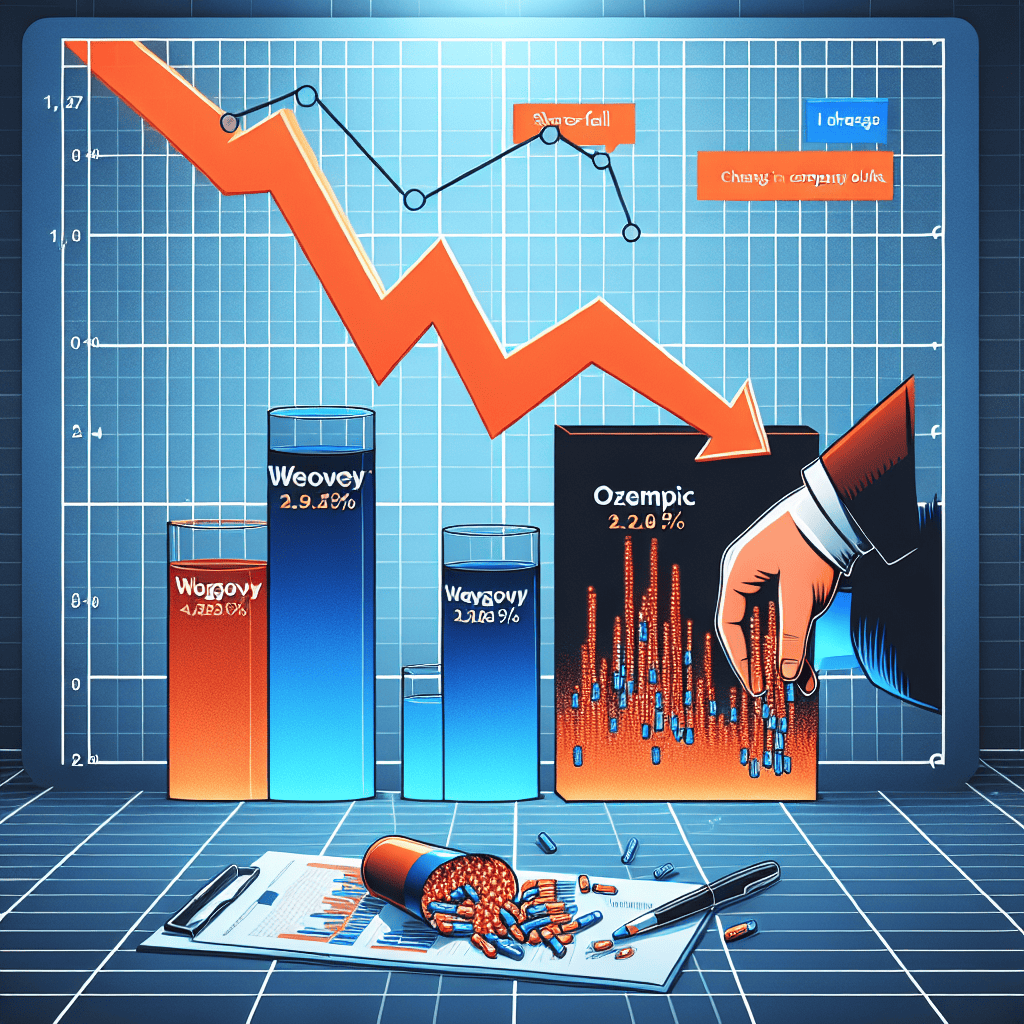“Novo Nordisk: Navigating Market Waves as Wegovy Shines, Ozempic Stumbles.”
Introduction
Novo Nordisk, a leading global healthcare company, recently experienced a decline in its share value following an adjustment to its financial outlook. This adjustment comes amid mixed performance from its key pharmaceutical products. While Wegovy, a medication designed for weight management, has surpassed market expectations with robust sales and strong demand, Ozempic, a drug used for managing type 2 diabetes, has not performed as well as anticipated. The contrasting outcomes of these products have prompted Novo Nordisk to reassess its financial projections, impacting investor confidence and leading to a noticeable drop in the company’s stock price.
Impact Of Novo Nordisk’s Adjusted Outlook On Investor Confidence
Novo Nordisk, a leading pharmaceutical company renowned for its diabetes and obesity treatments, recently experienced a decline in its share value following an adjustment to its financial outlook. This development has sparked considerable interest and concern among investors, as the company’s performance in the pharmaceutical market has been a focal point for stakeholders. The adjustment in outlook was primarily driven by the contrasting performances of two of its flagship products: Wegovy and Ozempic. While Wegovy has exceeded expectations, Ozempic has not performed as well as anticipated, leading to a recalibration of the company’s financial projections.
Wegovy, a weight management drug, has seen remarkable success in the market, significantly outperforming initial sales forecasts. This success can be attributed to the growing global demand for effective obesity treatments, as well as the drug’s proven efficacy in clinical trials. The positive reception of Wegovy has bolstered Novo Nordisk’s reputation in the obesity treatment sector, positioning the company as a leader in this rapidly expanding market. Consequently, the strong performance of Wegovy has provided a degree of reassurance to investors, highlighting the company’s potential for growth in the obesity treatment domain.
In contrast, Ozempic, a medication designed for the management of type 2 diabetes, has not met the company’s sales expectations. Despite its proven effectiveness in controlling blood sugar levels and its potential cardiovascular benefits, Ozempic has faced increased competition from other diabetes treatments. This competitive pressure has impacted its market share, leading to a reassessment of its projected sales figures. The underperformance of Ozempic has raised concerns among investors, as it underscores the challenges Novo Nordisk faces in maintaining its dominance in the diabetes treatment market.
The adjustment in Novo Nordisk’s financial outlook reflects the need to balance the successes and challenges associated with its product portfolio. While the company has demonstrated its ability to innovate and capture market share in the obesity treatment sector, the competitive landscape in diabetes management remains a significant hurdle. This duality in performance has led to a cautious approach in revising financial projections, aiming to provide a more accurate representation of the company’s future earnings potential.
Investor confidence, a critical component of Novo Nordisk’s market valuation, has been impacted by these developments. The decline in share value following the adjusted outlook indicates a degree of uncertainty among investors regarding the company’s ability to sustain its growth trajectory. However, it is important to note that the pharmaceutical industry is inherently volatile, with market dynamics and regulatory environments constantly evolving. As such, investors are likely to closely monitor Novo Nordisk’s strategic initiatives aimed at addressing the challenges in the diabetes sector while capitalizing on the opportunities presented by the obesity market.
In conclusion, Novo Nordisk’s recent adjustment to its financial outlook has had a notable impact on investor confidence. The contrasting performances of Wegovy and Ozempic have highlighted both the opportunities and challenges facing the company. While the success of Wegovy underscores Novo Nordisk’s potential for growth in the obesity treatment market, the underperformance of Ozempic serves as a reminder of the competitive pressures in the diabetes sector. Moving forward, the company’s ability to navigate these complexities will be crucial in restoring and maintaining investor confidence.
Wegovy’s Market Performance: A Deep Dive Into Its Success
Novo Nordisk, a leading pharmaceutical company, recently experienced a notable shift in its market dynamics, as reflected in the performance of its key products, Wegovy and Ozempic. The company’s shares took a hit following an adjustment in its financial outlook, a move that has drawn significant attention from investors and analysts alike. This adjustment was primarily driven by the contrasting performances of its two flagship drugs, Wegovy and Ozempic, which have shown divergent trajectories in the market.
Wegovy, a weight management medication, has emerged as a standout performer, exceeding expectations and capturing a substantial share of the market. Its success can be attributed to several factors, including its efficacy in promoting weight loss and its ability to address a growing demand for effective obesity treatments. The drug’s performance has been bolstered by positive clinical trial results, which have demonstrated its potential to deliver significant weight reduction in patients. Furthermore, Wegovy’s approval by regulatory bodies in various regions has facilitated its widespread adoption, contributing to its robust sales figures.
In contrast, Ozempic, a medication primarily used for managing type 2 diabetes, has not met the anticipated market performance. Despite its proven efficacy in controlling blood sugar levels and its additional benefits in weight management, Ozempic has faced challenges in maintaining its growth momentum. One of the contributing factors to its underperformance is the increasing competition in the diabetes treatment market, with several new entrants offering alternative solutions. Additionally, the shifting focus of healthcare providers and patients towards comprehensive weight management solutions has somewhat overshadowed Ozempic’s role as a diabetes treatment.
The divergent performances of Wegovy and Ozempic have prompted Novo Nordisk to reassess its financial projections. The company has adjusted its outlook to reflect the changing market dynamics, acknowledging the need to recalibrate its strategies to align with the evolving landscape. This adjustment, while necessary, has led to a decline in the company’s share prices, as investors react to the revised expectations. However, it is important to note that the overall market for obesity and diabetes treatments remains robust, offering significant opportunities for growth and innovation.
As Novo Nordisk navigates these challenges, the company is likely to focus on leveraging the success of Wegovy to bolster its market position. This may involve expanding its marketing efforts, enhancing patient access programs, and exploring new markets to maximize the drug’s potential. Simultaneously, the company may need to revisit its strategy for Ozempic, potentially exploring new indications or combination therapies to reinvigorate its market presence.
In conclusion, the contrasting performances of Wegovy and Ozempic underscore the complexities of the pharmaceutical market, where success is often contingent on a multitude of factors, including clinical efficacy, market demand, and competitive dynamics. Novo Nordisk’s recent experience highlights the importance of agility and adaptability in navigating these challenges. As the company moves forward, its ability to capitalize on the success of Wegovy while addressing the underperformance of Ozempic will be crucial in shaping its future trajectory. Despite the current setbacks, Novo Nordisk remains well-positioned to continue its leadership in the obesity and diabetes treatment markets, provided it can effectively align its strategies with the evolving needs of patients and healthcare providers.
Analyzing The Underperformance Of Ozempic In The Current Market
Novo Nordisk, a leading pharmaceutical company renowned for its innovative diabetes and obesity treatments, recently experienced a decline in its share value following an adjustment to its financial outlook. This adjustment was primarily influenced by the contrasting performances of two of its flagship products: Wegovy and Ozempic. While Wegovy has exceeded market expectations, Ozempic has not performed as anticipated, prompting a closer examination of the factors contributing to its underperformance in the current market landscape.
To begin with, it is essential to understand the context in which these two drugs operate. Both Wegovy and Ozempic are part of Novo Nordisk’s portfolio of GLP-1 receptor agonists, a class of medications that mimic the incretin hormones to regulate blood sugar levels and promote weight loss. Wegovy, specifically approved for chronic weight management, has captured significant attention due to its efficacy in helping patients achieve substantial weight loss. This has led to a surge in demand, particularly in markets where obesity is a growing concern. Consequently, Wegovy’s success has been a bright spot for Novo Nordisk, contributing positively to its revenue streams.
In contrast, Ozempic, primarily prescribed for type 2 diabetes management, has faced challenges that have hindered its market performance. One of the primary factors contributing to Ozempic’s underperformance is the increasing competition within the diabetes treatment market. With several pharmaceutical companies developing and marketing similar GLP-1 receptor agonists, Ozempic has encountered stiff competition, making it difficult to maintain its market share. Additionally, the introduction of newer diabetes medications with enhanced efficacy and fewer side effects has further intensified the competitive landscape, posing a challenge for Ozempic to differentiate itself.
Moreover, the evolving healthcare policies and reimbursement structures in various regions have also impacted Ozempic’s market performance. As healthcare systems strive to manage costs, there is a growing emphasis on cost-effectiveness and value-based care. This shift has led to more stringent reimbursement criteria for diabetes medications, affecting the accessibility and affordability of Ozempic for patients. Consequently, this has resulted in a slower uptake of the drug in certain markets, contributing to its underperformance.
Furthermore, patient adherence and perception play a crucial role in the success of any medication. In the case of Ozempic, some patients have reported concerns regarding its side effects, which include gastrointestinal issues such as nausea and vomiting. These side effects, although common with GLP-1 receptor agonists, can deter patients from continuing their treatment, thereby impacting the drug’s overall market performance. Addressing these concerns through patient education and support programs could potentially improve adherence rates and enhance Ozempic’s market position.
In light of these challenges, Novo Nordisk is likely to focus on strategic initiatives to bolster Ozempic’s market performance. This may include efforts to differentiate the drug through clinical trials that highlight its unique benefits, as well as collaborations with healthcare providers to improve patient education and support. Additionally, exploring opportunities to expand Ozempic’s indications or develop combination therapies could also enhance its competitive edge.
In conclusion, while Wegovy’s success has been a boon for Novo Nordisk, the underperformance of Ozempic underscores the complexities of navigating the competitive and evolving pharmaceutical market. By addressing the challenges faced by Ozempic and leveraging strategic initiatives, Novo Nordisk can potentially improve its market position and continue to deliver innovative solutions for diabetes management.
Strategic Implications Of Novo Nordisk’s Revised Financial Projections

Novo Nordisk, a global leader in diabetes care and obesity treatment, recently experienced a notable shift in its financial landscape, as reflected in the company’s revised financial projections. The Danish pharmaceutical giant adjusted its outlook, leading to a decline in its share prices. This adjustment was primarily driven by the contrasting performances of its two flagship products: Wegovy and Ozempic. While Wegovy, a weight management drug, has exceeded expectations, Ozempic, a treatment for type 2 diabetes, has not performed as anticipated. This divergence in product performance has significant strategic implications for Novo Nordisk, necessitating a reevaluation of its market strategies and resource allocation.
To begin with, the outperformance of Wegovy highlights the growing demand for effective weight management solutions. As obesity rates continue to rise globally, the market for weight loss medications is expanding rapidly. Wegovy’s success underscores Novo Nordisk’s ability to capitalize on this trend, positioning the company as a leader in the obesity treatment market. This success not only boosts the company’s revenue but also enhances its reputation as an innovator in addressing one of the most pressing public health challenges of our time. Consequently, Novo Nordisk may consider increasing its investment in research and development for obesity-related treatments, leveraging its expertise to further solidify its market position.
Conversely, the underperformance of Ozempic presents a challenge that Novo Nordisk must address strategically. Despite being a well-regarded treatment for type 2 diabetes, Ozempic has not met sales expectations, which could be attributed to several factors. These may include increased competition from other diabetes medications, market saturation, or potential shifts in treatment guidelines. To mitigate the impact of Ozempic’s underperformance, Novo Nordisk might explore strategies such as enhancing its marketing efforts, expanding its distribution channels, or even revisiting its pricing strategy to make the product more competitive.
Moreover, the contrasting performances of Wegovy and Ozempic necessitate a careful reassessment of Novo Nordisk’s overall product portfolio. The company must ensure that it maintains a balanced approach, supporting both its diabetes and obesity treatment segments. This balance is crucial, as it allows Novo Nordisk to diversify its revenue streams and reduce dependency on any single product. By doing so, the company can better withstand market fluctuations and maintain its financial stability.
In addition to product-specific strategies, Novo Nordisk’s revised financial projections may also prompt a broader evaluation of its strategic priorities. The company might consider exploring new markets or therapeutic areas to drive future growth. For instance, expanding into emerging markets with high obesity and diabetes prevalence could offer significant opportunities. Furthermore, Novo Nordisk could explore partnerships or acquisitions to enhance its capabilities and accelerate its growth trajectory.
In conclusion, the recent adjustment in Novo Nordisk’s financial outlook, driven by the divergent performances of Wegovy and Ozempic, presents both challenges and opportunities. While Wegovy’s success highlights the potential for growth in the obesity treatment market, Ozempic’s underperformance necessitates strategic adjustments. By carefully reassessing its market strategies, product portfolio, and strategic priorities, Novo Nordisk can navigate these challenges effectively and continue to thrive in the competitive pharmaceutical landscape. As the company adapts to these changes, it remains well-positioned to leverage its strengths and capitalize on emerging opportunities, ensuring its continued success in the years to come.
Investor Reactions To Novo Nordisk’s Share Price Decline
Novo Nordisk, a leading pharmaceutical company renowned for its diabetes and obesity treatments, recently experienced a decline in its share price following an adjustment to its financial outlook. This development has sparked varied reactions among investors, who are closely analyzing the implications of the company’s revised projections. The adjustment was primarily driven by the contrasting performances of two of its key products: Wegovy and Ozempic. While Wegovy, a weight management drug, has exceeded expectations, Ozempic, a diabetes medication, has not performed as anticipated. This divergence in product performance has led to a recalibration of the company’s financial forecasts, prompting a reassessment of its market position and future growth prospects.
Investors have been particularly attentive to the performance of Wegovy, which has emerged as a standout product in Novo Nordisk’s portfolio. The drug’s success can be attributed to its efficacy in aiding weight loss, a factor that has resonated well with both healthcare providers and patients. As obesity continues to be a significant global health challenge, the demand for effective weight management solutions is on the rise. Wegovy’s ability to deliver promising results has positioned it as a frontrunner in this burgeoning market, thereby contributing positively to Novo Nordisk’s revenue streams. Consequently, investors have expressed optimism about the long-term potential of Wegovy, viewing it as a key driver of the company’s growth.
Conversely, the underperformance of Ozempic has raised concerns among investors, as it has not met the high expectations set for it. Ozempic, which is primarily used for the treatment of type 2 diabetes, was anticipated to capture a substantial share of the diabetes market. However, its sales figures have fallen short of projections, leading to questions about its competitive positioning and market penetration. This underperformance has been attributed to several factors, including increased competition from other diabetes treatments and potential market saturation. As a result, investors are closely monitoring Novo Nordisk’s strategic initiatives to bolster Ozempic’s market presence and enhance its appeal to healthcare providers and patients.
In light of these developments, Novo Nordisk’s decision to adjust its financial outlook has been met with mixed reactions from the investment community. On one hand, the strong performance of Wegovy has instilled confidence in the company’s ability to innovate and capture new market opportunities. On the other hand, the challenges faced by Ozempic have underscored the complexities of navigating the competitive landscape of the pharmaceutical industry. Investors are keenly aware that the success of a pharmaceutical company hinges on its ability to balance the performance of its product portfolio and adapt to changing market dynamics.
As Novo Nordisk moves forward, investors will be closely watching how the company addresses the challenges associated with Ozempic while capitalizing on the success of Wegovy. The company’s strategic decisions in the coming months will be pivotal in shaping investor sentiment and determining its share price trajectory. In this context, Novo Nordisk’s ability to effectively communicate its plans and demonstrate resilience in the face of market fluctuations will be crucial. Ultimately, the company’s performance will be judged not only by its financial metrics but also by its capacity to innovate and maintain a competitive edge in the ever-evolving pharmaceutical landscape.
Comparative Analysis: Wegovy Vs. Ozempic In The Pharmaceutical Market
In the ever-evolving pharmaceutical market, the performance of key products can significantly impact a company’s financial outlook and investor sentiment. Recently, Novo Nordisk, a leading player in the diabetes and obesity treatment sectors, experienced a notable shift in its market dynamics. The company’s shares fell after it adjusted its financial outlook, a move that was largely influenced by the contrasting performances of its two flagship products: Wegovy and Ozempic. This development has sparked a comparative analysis of these two drugs, highlighting their roles and implications in the pharmaceutical landscape.
Wegovy, a weight management medication, has been a standout performer for Novo Nordisk. Its success can be attributed to its efficacy in helping patients achieve significant weight loss, a factor that has resonated well with both healthcare providers and patients. The drug’s ability to address a growing global concern—obesity—has positioned it as a critical player in Novo Nordisk’s portfolio. As obesity rates continue to rise worldwide, the demand for effective weight management solutions has surged, providing Wegovy with a robust market opportunity. Consequently, its strong sales performance has been a key driver in bolstering Novo Nordisk’s revenue streams.
In contrast, Ozempic, a medication primarily used for managing type 2 diabetes, has not met the company’s expectations. Despite its proven efficacy in controlling blood sugar levels and offering cardiovascular benefits, Ozempic’s market performance has been underwhelming. Several factors may contribute to this underperformance. Firstly, the competitive landscape for diabetes treatments is intense, with numerous alternatives available to healthcare providers. This saturation makes it challenging for any single product to dominate the market. Additionally, the economic pressures faced by healthcare systems globally may have led to more cautious spending on diabetes medications, further impacting Ozempic’s sales.
The divergent trajectories of Wegovy and Ozempic underscore the complexities of the pharmaceutical market, where product success is influenced by a myriad of factors, including clinical efficacy, market demand, and competitive pressures. For Novo Nordisk, the strong performance of Wegovy has been a silver lining, helping to offset some of the financial impacts of Ozempic’s underperformance. However, the company’s decision to adjust its financial outlook reflects the need to recalibrate expectations in light of these market realities.
This situation also highlights the importance of strategic product positioning and market adaptation. As Novo Nordisk navigates these challenges, it may need to explore new strategies to enhance Ozempic’s market appeal, such as targeted marketing campaigns or collaborations with healthcare providers to emphasize its unique benefits. Simultaneously, capitalizing on Wegovy’s success by expanding its market reach and exploring new indications could further strengthen the company’s position in the obesity treatment sector.
In conclusion, the contrasting performances of Wegovy and Ozempic offer valuable insights into the dynamics of the pharmaceutical market. While Wegovy’s success underscores the potential of addressing unmet medical needs, Ozempic’s challenges highlight the competitive pressures and economic considerations that companies must navigate. For Novo Nordisk, these developments necessitate a strategic approach to ensure sustained growth and shareholder confidence. As the company adjusts its outlook, the lessons learned from this comparative analysis will likely inform its future strategies in an increasingly complex and competitive market.
Future Prospects For Novo Nordisk Amidst Mixed Drug Performance
Novo Nordisk, a leading player in the global pharmaceutical industry, recently experienced a notable shift in its market dynamics, as reflected in the fluctuation of its share prices. The company’s decision to adjust its financial outlook has sparked considerable interest and concern among investors and analysts alike. This adjustment comes in the wake of mixed performance results from two of its key products: Wegovy and Ozempic. While Wegovy has exceeded expectations, Ozempic has not performed as anticipated, leading to a complex scenario for the company’s future prospects.
Wegovy, a weight management drug, has been a standout performer for Novo Nordisk. Its success can be attributed to the growing global demand for effective obesity treatments, driven by increasing awareness of the health risks associated with obesity and the need for sustainable weight management solutions. The drug’s impressive performance has been bolstered by positive clinical trial results and strong market uptake, which have collectively contributed to its robust sales figures. This success has provided a significant boost to Novo Nordisk’s revenue streams, reinforcing its position as a leader in the obesity treatment market.
Conversely, Ozempic, a medication designed for the management of type 2 diabetes, has not met the company’s expectations. Despite its initial promise and the substantial investment in its development and marketing, Ozempic’s sales have lagged behind projections. Several factors may have contributed to this underperformance, including increased competition in the diabetes treatment market and potential challenges in differentiating the product from other available options. Additionally, regulatory hurdles and varying healthcare policies across different regions may have further complicated its market penetration.
In light of these mixed results, Novo Nordisk has taken the prudent step of adjusting its financial outlook. This move reflects the company’s commitment to transparency and its proactive approach to managing investor expectations. By recalibrating its projections, Novo Nordisk aims to provide a more accurate representation of its financial health and future growth potential. This adjustment, while necessary, has inevitably led to a decline in the company’s share prices, as investors reassess their positions in response to the updated outlook.
Looking ahead, Novo Nordisk faces both challenges and opportunities. The success of Wegovy presents a promising avenue for growth, as the company can leverage its expertise and market presence to further expand its footprint in the obesity treatment sector. Continued investment in research and development, coupled with strategic partnerships and collaborations, could enhance the drug’s market reach and solidify its competitive edge. On the other hand, addressing the underperformance of Ozempic will require a multifaceted approach. This may involve refining marketing strategies, exploring new markets, and potentially innovating the product to better meet the needs of patients and healthcare providers.
In conclusion, Novo Nordisk’s recent experiences with Wegovy and Ozempic underscore the complexities inherent in the pharmaceutical industry. While the company’s adjusted outlook has led to a temporary dip in share prices, its long-term prospects remain promising, provided it can effectively navigate the challenges and capitalize on the opportunities presented by its diverse product portfolio. As the company continues to adapt to the evolving healthcare landscape, its ability to innovate and respond to market demands will be crucial in shaping its future trajectory.
Q&A
1. **What caused Novo Nordisk shares to fall?**
Novo Nordisk shares fell after the company adjusted its financial outlook.
2. **Which product outperformed expectations?**
Wegovy outperformed expectations.
3. **Which product underperformed expectations?**
Ozempic underperformed expectations.
4. **How did the performance of Wegovy impact the company?**
The strong performance of Wegovy was a positive factor, but it was not enough to offset the negative impact of the adjusted outlook.
5. **What was the market’s reaction to the adjusted outlook?**
The market reacted negatively, leading to a decline in Novo Nordisk’s share price.
6. **Did the underperformance of Ozempic have a significant impact?**
Yes, the underperformance of Ozempic contributed to the company’s decision to adjust its outlook, impacting investor sentiment.
7. **What is the significance of adjusting the financial outlook for a company?**
Adjusting the financial outlook can indicate changes in expected revenue or profit, affecting investor confidence and share prices.
Conclusion
Novo Nordisk’s recent adjustment in its financial outlook has led to a decline in its share prices, despite the strong performance of its weight-loss drug Wegovy. The market’s reaction suggests that investors are concerned about the underperformance of Ozempic, a key diabetes treatment, which may impact the company’s overall growth prospects. While Wegovy’s success highlights Novo Nordisk’s potential in the obesity treatment market, the underperformance of Ozempic underscores the challenges the company faces in maintaining its leadership in the diabetes sector. This mixed performance necessitates strategic adjustments to balance and optimize its product portfolio for sustained growth.




